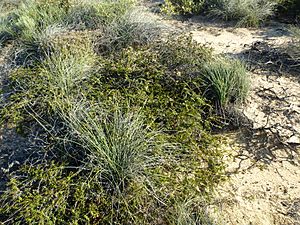Melaleuca longistaminea facts for kids
Quick facts for kids Melaleuca longistaminea |
|
|---|---|
 |
|
| M. longistaminea growing at Red Bluff near Kalbarri. | |
| Scientific classification | |
| Genus: |
Melaleuca
|
| Species: |
longistaminea
|
| Synonyms | |
|
Melaleuca cardiophylla var. longistaminea F.Muell. |
|
Melaleuca longistaminea is a special plant that belongs to the myrtle family, called Myrtaceae. You can only find it growing naturally in the southwest part of Western Australia. This plant is a type of shrub, which means it's a woody plant smaller than a tree. It has small, prickly leaves that look a bit like hearts. In winter and spring, you'll see pretty yellow to green flowers growing in clusters along its stems. It looks a lot like another plant called Melaleuca spectabilis, but Melaleuca longistaminea has bigger flower clusters and wider leaves.
Contents
What Melaleuca longistaminea Looks Like
Melaleuca longistaminea is a woody shrub that can grow up to 2 m (7 ft) tall. It has many branches that spread out, and its branches and leaves are smooth, meaning they don't have hairs. Its leaves grow one after another along the stem.
Leaves and Their Features
The leaves are usually between 4.5 mm (0.2 in) and 13.5 mm (0.5 in) long. They are also 3 mm (0.1 in) to 11.5 mm (0.5 in) wide. Each leaf is shaped like an egg or a heart and ends in a sharp point. You can see 11 to 19 straight lines, or veins, running through the leaves. These veins make the leaves look like they have fine stripes.
Flowers and Fruits
The flowers of Melaleuca longistaminea are a lovely lime-green to yellow color. They grow in round clusters on the sides of the branches. These flower clusters can be up to 45 mm (2 in) across. Each cluster is made up of 5 to 15 individual flowers.
The petals of the flowers are about 3 mm (0.12 in) to 3.7 mm (0.15 in) long. They fall off as the flower gets older. Around the center of each flower, there are five groups of stamens. Stamens are the parts of a flower that produce pollen. Each group has 9 to 24 stamens.
This plant flowers from June to October. After the flowers, it produces woody fruits called capsules. These capsules are 3.5 mm (0.1 in) to 6.5 mm (0.3 in) long. They grow in clusters of 7 to 15 along the branches.
How This Plant Got Its Name
The scientific name Melaleuca longistaminea was first officially given in 1999 by a scientist named Lyndley Craven. He published this name in a scientific journal called Australian Systematic Botany.
History of Its Discovery
However, this plant was first described way back in 1863 by another scientist, Ferdinand von Mueller. He originally thought it was a subspecies of another plant, calling it Melaleuca cardiophylla subsp. longistaminea. He found a sample of the plant near the Murchison River.
Meaning of the Name
The second part of its name, longistaminea, comes from two Latin words. Longus means "long," and stamen refers to the stamens of the flower. This name was chosen because this plant has longer stamens compared to similar species.
Where Melaleuca longistaminea Grows
You can find Melaleuca longistaminea in certain areas of Western Australia. It grows in the regions around the Murchison River, Carnamah, and Wongan Hills. These areas are part of what scientists call the Avon Wheatbelt and Geraldton Sandplains biogeographic regions.
Its Favorite Places to Live
This plant likes to grow in different types of environments. You can find it in heathlands, which are open areas with small shrubs. It also grows in shrublands and scrub areas. It prefers sandy soil that is found over sandstone and granite rocks.
Is It Endangered?
The good news is that Melaleuca longistaminea is currently listed as "not threatened." This means it is not considered to be in danger of disappearing. The Government of Western Australia Department of Parks and Wildlife keeps track of its status.
Images for kids
-
Habit at Red Bluff, near Kalbarri




